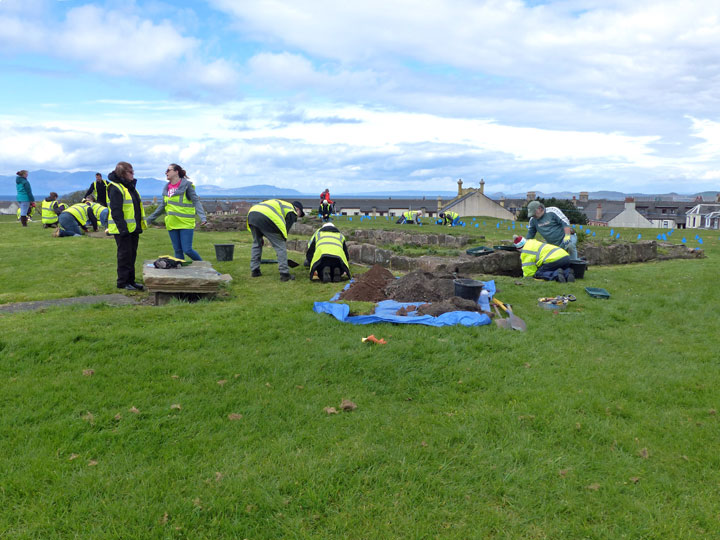
Castle Hill Church and Graveyard 20 29 April 2017
The church on Castle Hill was originally a Catholic Church, built no later than 1226. It measured 64 feet by 26 feet. It had two altars - one dedicated to Saint Peter and the other to the Blessed Virgin Mary. It became a Church of Scotland after the Reformation of 1560 and was destroyed in a storm in 1695..
Ardrossan Castle Heritage Society commissioned an archaeological survey in and around the church on the Castle Hill. On the weekends of 29 and 30 April and 13 and 14 May, under the supervision of Tom Rees and Joss Durnan of Rathmell Archaeology of Kilwinning, volunteers made targeted digs and found some interesting artefacts and information. A stimulus to undertaking this project was the desire to know more about the church in which a stone coffin or sarcophagus was unearthed in 1911 by Robert Cook, an Ardrossan Town Council workman. The Society wanted to know more about the ruin and its surrounding graveyard.
The main findings on the first weekend were two courses of hidden church stonework, fragments of skull one of which had two teeth, two large stone slabs inside the church, medieval pottery, a buried gravestone, the stone boundary that surrounded the graveyard and the teeth of cattle. The cattle were likely to be of the Chillingham herd or Ardrossan White Cattle that lived on the Hill in the late 1700s and early 1800s. In addition, the gravestones in the graveyard were cleaned. On the second weekend, the floor of the church was exposed for the first time in over a century since the Ardrossan Sarcophagus was unearthed in 1911. The presence of human bones and skull fragments suggests that the church was a burial place, most likely for high-ranking people. Stone slabs on the north and south walls were likely to have been seating for the clergy or gentry. Some gravestones were cleaned to make the eroded inscriptions more legible.
Among the visitors was former Ardrossan resident, Dr David Caldwell, retired Keeper of the Museums of Scotland and Europe and an authority on Ardrossan Castle. David is the President of the Society of Antiquaries of Scotland and Honorary President of the Heritage Society. He was very impressed with the turnout of keen local volunteers and their enthusiasm. He was pleased to see so many people taking an interest in Ardrossan's heritage and its Castle and old church getting the attention and recognition they deserve. He added that the work carried out will add considerably to the understanding of the church and will eventually provide more information on who was buried in the graveyard. Among the volunteers were two pupils from Ardrossan Academy, Niamh Templeton and Linzi Smith who discovered a stone slab in the church. They worked very hard and enjoyed their archaeological experience. The Heritage Society was delighted when a special visitor came along. George Phillips is the great grandson on Robert Cook, the man who discovered the sarcophagus in 1911. He takes an interest in the work of the Society and wanted to see the dig for himself. George stood at the very spot at which his great grandfather found the sarcophagus 106 years previously.